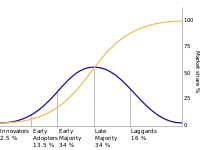
Photo from wikipedia
Exploring the behavior change process has been of interest and importance to public health professionals, to translate research into practice. Diffusion of innovations (DOI) model has been extensively applied in… Click to show full abstract
Exploring the behavior change process has been of interest and importance to public health professionals, to translate research into practice. Diffusion of innovations (DOI) model has been extensively applied in public health to examine the process by which innovation is passively communicated to individuals and groups. It builds on a staged model of awareness, persuasion, decision, implementation, and confirmation; and categorizes communities into innovators (2.5%), early adopters (13.5%), early majority (34%), late majority (34%) and laggards (16%). It reflects on the diversity of strategies to be applied for different cadres of the society to bring about a wholistic change. Nonetheless, DOI suffers from 'pro-innovation' and 'individual blame' bias, as it fails to account for the influence of societal, cultural, and extraneous factors affecting individual behavior change. The social networks theory (SNT) in contrast, explains behavior change based on social networks and their influences. It builds on the constructs of homophily, centralization, reciprocity, transitivity, and density; and fills the void in the DOI model. We suggest public health professionals to combine the constructs of DOI and SNT in rolling out behavior change interventions, to yield a comprehensive approach.
Journal Title: Scandinavian journal of public health
Year Published: 2021
Link to full text (if available)
Share on Social Media: Sign Up to like & get
recommendations!